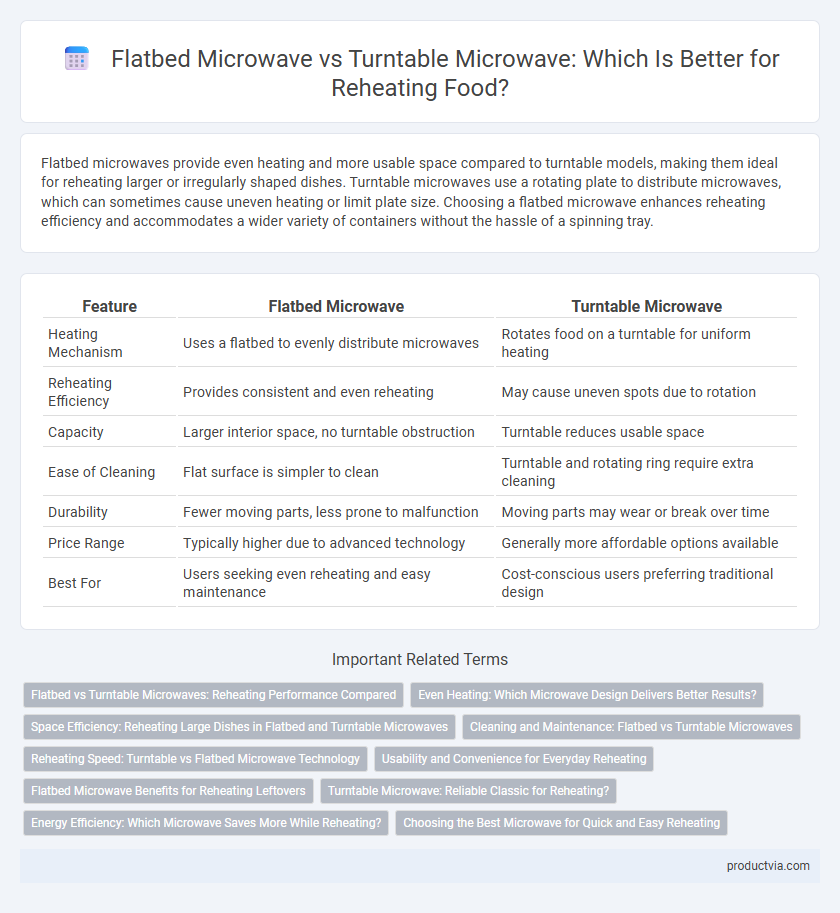Flatbed microwaves provide even heating and more usable space compared to turntable models, making them ideal for reheating larger or irregularly shaped dishes. Turntable microwaves use a rotating plate to distribute microwaves, which can sometimes cause uneven heating or limit plate size. Choosing a flatbed microwave enhances reheating efficiency and accommodates a wider variety of containers without the hassle of a spinning tray.
Table of Comparison
| Feature | Flatbed Microwave | Turntable Microwave |
|---|---|---|
| Heating Mechanism | Uses a flatbed to evenly distribute microwaves | Rotates food on a turntable for uniform heating |
| Reheating Efficiency | Provides consistent and even reheating | May cause uneven spots due to rotation |
| Capacity | Larger interior space, no turntable obstruction | Turntable reduces usable space |
| Ease of Cleaning | Flat surface is simpler to clean | Turntable and rotating ring require extra cleaning |
| Durability | Fewer moving parts, less prone to malfunction | Moving parts may wear or break over time |
| Price Range | Typically higher due to advanced technology | Generally more affordable options available |
| Best For | Users seeking even reheating and easy maintenance | Cost-conscious users preferring traditional design |
Flatbed vs Turntable Microwaves: Reheating Performance Compared
Flatbed microwaves offer more even reheating performance due to their rotating antenna, which distributes microwave energy uniformly across the food, eliminating the hot and cold spots common in turntable models. Turntable microwaves rely on a rotating glass tray to move the food through the stationary microwave energy, often resulting in uneven heating and requiring food rotation for better results. Flatbed designs maximize internal space and improve reheating consistency, making them a superior choice for uniform warming of leftovers and microwaved meals.
Even Heating: Which Microwave Design Delivers Better Results?
Flatbed microwaves provide more even heating by utilizing a rotating antenna beneath a flat surface, eliminating the need for a turntable and allowing food to heat uniformly without rotating. Turntable microwaves rely on a rotating plate to expose food to microwave energy from different angles, but can result in uneven cooking when items are irregularly shaped or oversized. Studies show that flatbed microwave designs consistently deliver better results in reheating by reducing hot and cold spots, ensuring more consistent temperature distribution throughout the food.
Space Efficiency: Reheating Large Dishes in Flatbed and Turntable Microwaves
Flatbed microwaves maximize interior space by eliminating the rotating turntable, allowing large dishes to fit and heat evenly without obstruction. Turntable microwaves often have limited usable space due to the spinning tray, which can restrict the size and shape of containers for reheating. This makes flatbed models more space-efficient for reheating bulky or irregularly shaped meals.
Cleaning and Maintenance: Flatbed vs Turntable Microwaves
Flatbed microwaves offer easier cleaning and maintenance since their flat, turntable-free interiors eliminate dirt and food trap points found in traditional turntable models, allowing for straightforward wiping of the entire cooking cavity. Turntable microwaves require regular removal and cleaning of the glass tray and rotating ring, which can accumulate food debris and grease. The absence of moving parts in flatbed microwaves also reduces the risk of mechanical failure, contributing to lower long-term maintenance needs.
Reheating Speed: Turntable vs Flatbed Microwave Technology
Flatbed microwave technology uses a stationary, flat heating surface combined with advanced wave distribution to provide faster and more even reheating compared to turntable microwaves, which rely on rotating plates to circulate microwaves. Turntable microwaves often face uneven heating and longer reheating times due to inconsistent wave patterns and food placement. Flatbed microwaves optimize microwave energy, significantly reducing reheating speed while ensuring uniform heat distribution across the entire food surface.
Usability and Convenience for Everyday Reheating
Flatbed microwaves offer more even heating and increased interior space, making them ideal for reheating larger dishes without rotating trays obstructing placement. Turntable microwaves are generally more affordable and provide reliable, consistent reheating through rotating trays that ensure food spins for uniform warming. For everyday usability and convenience, flatbed models simplify cleaning and accommodate various container sizes, while turntable models deliver straightforward operation and efficiency.
Flatbed Microwave Benefits for Reheating Leftovers
Flatbed microwaves offer uniform heating by eliminating the turntable mechanism, allowing food to reheat evenly without rotating, which minimizes cold spots in leftovers. Their spacious flat interior accommodates larger dishes and irregularly shaped containers, enhancing convenience during reheating. Energy efficiency in flatbed microwaves reduces cooking time, preserving food texture and moisture better than traditional turntable models.
Turntable Microwave: Reliable Classic for Reheating?
Turntable microwaves provide consistent reheating by rotating food evenly, preventing cold spots and ensuring thorough warming. Their reliable, classic design offers a practical solution for everyday use, especially for dishes with uneven shapes or sizes. This mechanism enhances heat distribution, making turntable microwaves a favored choice for dependable reheating performance.
Energy Efficiency: Which Microwave Saves More While Reheating?
Flatbed microwaves use a rotating antenna beneath a flat surface to evenly distribute microwaves, reducing hot spots and improving energy efficiency during reheating. Turntable microwaves rely on a rotating glass tray to circulate food, which can sometimes cause uneven heating and longer cooking times, potentially consuming more energy. Energy-saving tests show flatbed models generally require less time and power to reheat food uniformly compared to turntable microwaves.
Choosing the Best Microwave for Quick and Easy Reheating
Flatbed microwaves provide more even heating and greater interior space compared to turntable microwaves, making them ideal for reheating large or irregularly shaped dishes quickly. Turntable microwaves use a rotating plate to distribute microwaves evenly but often have limited space and can cause uneven heating with bulky containers. For quick and easy reheating, flatbed microwaves offer superior convenience and performance by eliminating the need for turntable rotation and maximizing usable cooking area.
Flatbed Microwave vs Turntable Microwave for reheating Infographic

 productvia.com
productvia.com